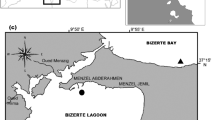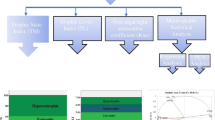Abstract
The algal growth potential (AGP) in water samples of the Danube wetland waters (1388–1426 r. km) as well as the effect of nitrogen (in final concentration of 0.16 g l−1) and phosphorus enrichment (in final concentration of 0.02 g l−1) on the AGP was investigated by miniaturized bioassay method. Values of the total biomass of Chlorella kessleri up to the 14th day of incubation were suitable for the evaluation of trophic conditions according to the classification of AGP. On the basis of the AGP results, trophic conditions in 55% of the samples were oligo-mesotrophic and in 46% of the samples meso-eutrophic. A statistically significant correlation (r = 0.34) was established between the AGP of C. kessleri in original water samples and NO3 concentrations in situ. The TN/TP ratio in the wetland waters indicated a greater limitation due to nitrogen than phosphorous. Significantly lower TSITN than TSISD, TSIChla and TSITP indicated nitrogen limited conditions. In order to quantify established nutrient limitation by the bioassay method, the effect of added N and P concentrations on the growth rate of C. kessleri was expressed as the degree of nutrient limitation (Δr d−1) during 7 days of incubation. In the Danube wetland waters only N limitation was established in June and July; N and P limitation in May and September while in August and October 2003 neither of the tested nutrients were limiting. From May to October 2003 the significantly highest degree of nitrogen (Δr = 0.736 d−1) and phosphorus limitation (Δr = 0.474 d−1) was determined in Lake Sakadaš.
Similar content being viewed by others
References
(1985). American Public Health Association Standard Methods for the Examination of Water and Wastewater. APHA, Washington DC
Ault T., Velzeboer R. and Zammit R. (2000). Influence of nutrient availability on phytoplankton growth and community structure in the Port Adelaide River, Australia: bioassay assessment of potential nutrient limitation. Hydrobiologia 429: 89–103
Bischoff H. W. and Bold C. H. (1963). Phycological Studies IV. Some soil algae from Enchanted Rock and related algal species University of Texas Publication. Austin 6318: 1–95
Carlson R. E. (1977). A trophic state index for lakes. Limnology and Oceanography 22: 361–369
Diaz M. M. and Pedrozo F. L. (1996). Nutrien limitation in Andean-Patagonian lakes at latitude 40–41 °S. Archiv für Hydrobiologie 138: 123–143
Dodds W. K., Smith V. H. and Lohman K. (2002). Nitrogen and phosphorus relationships to benthic algal biomass in temperate streams. Canadian Journal of Fisheries and Aquatic Sciences 59: 865–874
Downing J. A., Osenberg C. W. and Sarnelle O. (1999). Metanalysis of marine nutrient enrichment experiments: variation in the magnitude of nutrient limitation. Ecology 80: 1157–1167
Horvatić J. (1989). Phytoplankton of the Sunčani kanal in the Special zoological reservation “Kopački rit”. Periodicum Biologorum 91: 176
Horvatić J. and Gucunski D. (1997). Comparative investigations of phytoplankton in the Stara Drava and in the Lake Sakadaš. Periodicum Biologorum 99: 97–102
Horvatić J. and Lukavsky J. (1997). Algal growth potential (AGP) and toxicity of the waters of the Stara Drava channels and the Lake Sakadaš (Kopački rit, Croatia). Archiv für Hydrobiologie Supplement 120, Algological Studies 86: 163–170
Horvatić, J., Ž. Vidaković-Cifrek, & I. Regula, 2000. Trophic Level, Bioproduction and Toxicity of the water of Lake Sakadaš. In Horvatić, J. (ed.), Limnological Reports, International Association for Danube Research, Osijek 33: 89–94
Horvatić J., Mihaljević M. and Stević F. (2003a). Algal growth potential of Chlorella kessleri FOTT et NOV. in comparison with in situ microphytoplankton dynamics in the water of Lake Sakadaš marshes. Periodicum Biologorum 105: 307–312
Horvatić J., Palijan G. and Lukavský J. (2003b). Algal responses to nutrient additions in water of Nature Park Kopački rit (Croatia) by Miniaturized Algal Growth Bioassay. Archiv für Hydrobiologie Supplement 149, Algological Studies 110: 117–126
ISO 8692, 1989. Water quality - Fresh water algal growth inhibition test with Scenedesmus subspicatus and Selenastrum capricornutum
Kinnear A. and Garnett P. (1999). Water chemistry of the wetlands of the Yellagonga Regional Park, Western Australia. Journal of the Royal Society of Western Australia 82: 79–85
Kisand A. and Nõges P. (2003). Sediment phosphorus release in phytoplankton dominated versus macrophyte dominated shallow lakes: importance of oxygen conditions. Hydrobiologia 506–509: 129–123
Komárková J. (1989). Primárni produkce řas ve slatkovodních ekosysteméch. In: Dykyová, D. (eds) Metody studia ecosystémů, pp 330–347. Academia Praha, Praha
Kratzer C. R. and Brezonik P. L. (1981). A Carlson-type trophic state index for nitrogen in Florida Lakes. Water Resources Bulletin 17: 713–715
Lukavský J. (1983). The evaluation of algal growth potential by cultivation on solid media. Water Research 17: 549–558
Lukavský J. (1992). The evaluation of algal growth potential (AGP) and toxicity of water by miniaturized growth bioassay. Water Research 26: 1409–1413
Lukavský, J., 1994. Miniaturized algal growth bioassay. In: Aubrecht, G., G. Dickand & C. Prentice (eds), Monitoring of Ecological Change in Wetlands of Middle Europe. Proceedings of International Workshop, Linz, Austria, 1993. Staphia 31: Linz, Austria and IWRB Publication No. 30, Slimbridge, UK, 151–156
Marvan P. and Žáková Z. (1981). Expressing of results. In: Žáková, Z. (eds) Evaluation of AGP, pp 68–70. Dum Techniky ČSVTS, Brno
Mihaljević M., Getz D., Tadić Z., Živanović B., Gucunski D., Topić J., Kalinović I. and Mikuska J. (1999). Kopački rit. Pregled istraživanja i bibliografija. HAZU, Zavod za znanstveni rad Osijek, Zagreb-Osijek
Miller, W. E., J. Greene & T. Shiroyama, 1978. The Selenastrum capricornutum PRINTZ algal assay bottle test. EPA Re. No. 600/9–78–818, Oregon
Olde Venternik H., Pieterse N. M., Belgers J. D. M. and Wassen M. J. (2002). N, P, and K budgets along nutrient availability and productivity gradients in wetlands. Ecological Applications 12: 1010–1026
Osenberg C. W., Sarnelle O., Cooper S. D. and Holt R. D. (1999). Resolving ecological questions through meta-analysis: goals, metrics, and models. Ecology 80: 1105–1117
Peršić V., Horvatić J. and Mihaljević M. (2005). Bioassay method in the trophic evaluation of wetland area-a case study in the Danubian region (1426–1388 r. km). Periodicum Biologorum 107: 299–304
Scheffer M. (2001). Ecology of Shallow Lakes. Kluwer Academic Publishers, Dordrecht, Boston, London
Sládeček V. (1979). Biological evaluation of trophy and eutrophication. Proceedings of 5th Conference Czechoslovak Limnological Society, Ustí nad Labem, 75–78
Søndergaard M., Jensen J. P. and Jeppesen E. (2003). Role of sediment and internal loading of phosphorus in shallow lakes. Hydrobiologia 506–509: 135–145
Stanley E. H., Johnsson M. D. and Ward A. K. (2003). Evaluating the influence of macrophytes on algal and bacterial production in multiple habitats of freshwater wetland. Limnology and Oceanography 48: 1101–1111
Stević F., Mihaljević M. and Horvatić J. (2005). Interactions between microphytoplankton of the Danube, its sidearms and wetlands (1426–1388 r. km, Croatia). Periodicum Biologorum 107: 299–304
Verhoeven J. T. A., Whigham D. F., Logtestjin R. and O´Neill J. (2001). A comparative study of nitrogen and phosphorus cycling in tidal and non-tidal riverine wetlands. Wetlands 21: 210–222
Giani A. (2004). Effect of nitrate and ammonium on the growth and protein concentration of Microcystis viridis Lemmermann (Cyanobacteria). Revista Brasileira de Botânica 27: 325–331
Wetzel R.G. (2001). Limnology. Lake and River Ecosystems. Third Ed. Academic Press, San Diego, 1006
Žáková Z. (1986). Criteria for evaluation of trophy and eutrophication, mapping. In: Lhotsky, O., Žáková, Z., and Marvan, P. (eds) Algal Assays and their Application, pp 41–47. ČSVTS, Brno
Author information
Authors and Affiliations
Corresponding author
Rights and permissions
About this article
Cite this article
Horvatić, J., Peršić, V. & Mihaljević, M. Bioassay Method in Evaluation of Trophic Conditions and Nutrient Limitation in the Danube Wetland Waters (1388–1426 r. km). Hydrobiologia 563, 453–463 (2006). https://doi.org/10.1007/s10750-006-0035-1
Received:
Revised:
Accepted:
Published:
Issue Date:
DOI: https://doi.org/10.1007/s10750-006-0035-1




